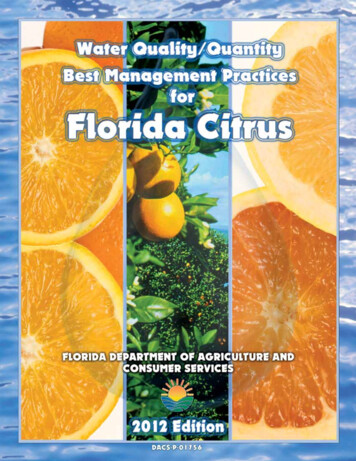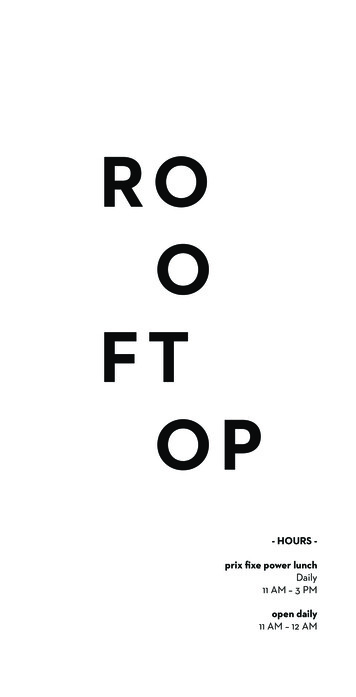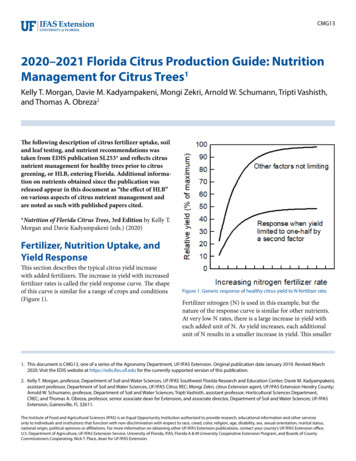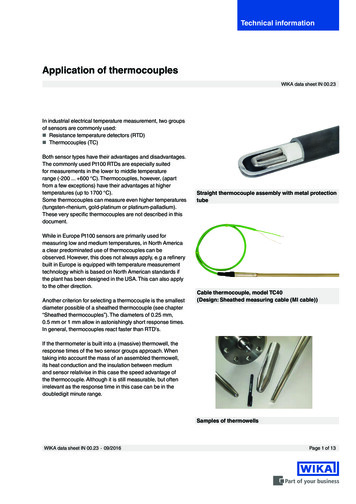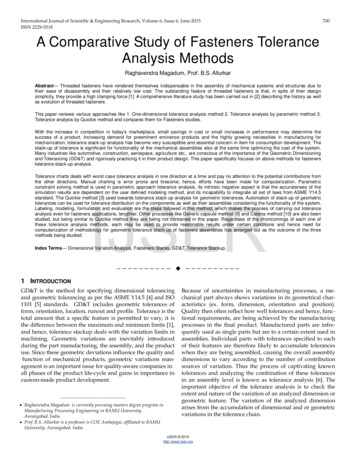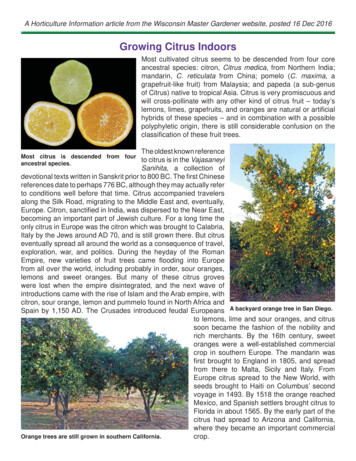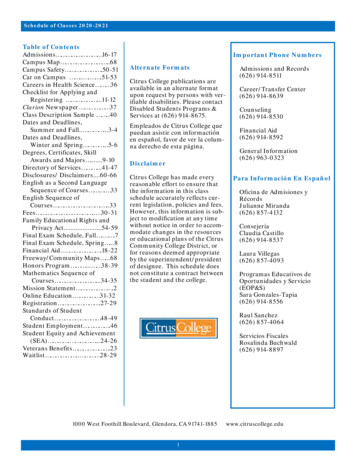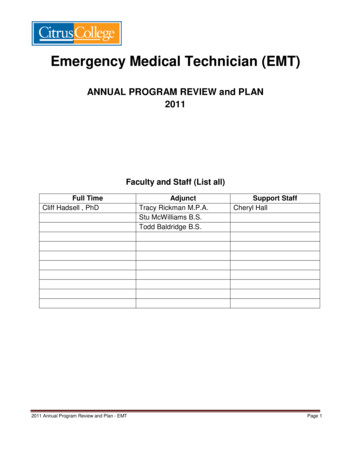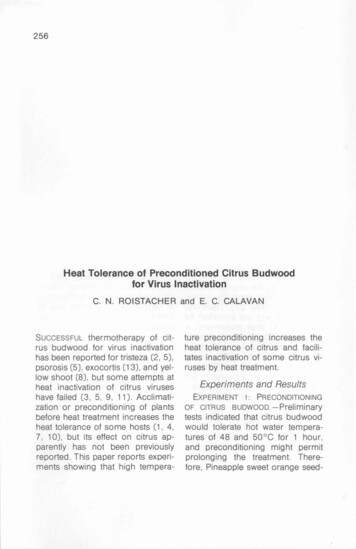
Transcription
Heat Tolerance of Preconditioned Citrus Budwoodfor Virus InactivationC. N. ROISTACHER and E. C. CALAVANSUCCESSFULthermotherapy of citrus budwood for virus inactivationhas been reported for tristeza (2, 53,psorosis (3,exocortis (1 3), and yellow shoot (8), but some attempts atheat inactivation of citrus viruseshave failed (3, 5, 9, 1 1 ). Acclimatization or preconditioning of plantsbefore heat treatment increases theheat tolerance of some hosts (1, 4,7, lo), but its effect on citrus apparently has not been previouslyreported. This paper reports experiments showing that high tempera-ture preconditioning increases theheat tolerance of citrus and facilitates inactivation of some citrus viruses by heat treatment.Experiments and ResultsEXPERIMENTI : PRECONDITIONINGOF CITRUS BUDWOOD.-Preliminarytests indicated that citrus budwoodwould tolerate hot water temperatures of 48 and 50 C for 1 hour,and preconditioning might permitprolonging the treatment. Therefore, Pineapple sweet orange seed-
PHYSIOLOGICAL and BIOCHEMICAL ASPECTSlings were preconditioned for 28weeks in a greenhouse compartment at 38-42OC maximum and30-31 OC minimum temperatures,in August 1965. Comparative controls were kept in another room at27-33OC maximum and 20-22 Cminimum temperatures. Groups of6 budsticks, 8 cm long, from plantsin each room were immersed in agi-257nonpreconditioned buds. Survivingbudsfrom all treatments grew. Theseresults indicated the value of preconditioning for increasing the heattolerance of citrus.EXPERIMENT2: HOTWATER TREATMENTS OF VIRUS-INFECTED CITRUS. -Viruses and hosts were: exocortis inmandarin, concave gum in sweetorange, tristeza in Mexican lime, veinT A B L E 1. THE EFFECT OF PRECONDITIONING ONSURVIVAL OF PINEAPPLESWEET ORANGEBUDWOOD TREATED I N HOT WATER--Hot watertreatmentsBudwoodsourcepreconditionedaBudT m e surv valBud(hrs)(of 20)growthTemp( O C)Control48485050Control o n r e c o n d i t i o n e d 191592015/197/157/91/2a. Budwood was preconditioned for 2 8 weeks at temperaturesof 30-31' minimum and 38-42'C maximum.b. Normal temperatures were 20-22' minimum and 27-33'Cmaximum.tated hot water at 48 and 50 C for2 and 3 hours. Then, 20 buds fromeach group, including untreatedcontrols, were grafted promptly to2 rough lemonseedlings. Six weekslater, buds were evaluated for survival and growth. Ninety-three percent of buds from preconditionedshoots survived heat treatment compared with 33 per cent for nonpreconditioned buds (Table 1). Preconditioned buds treated at 50 C for 2and 3 hours showed 90 per centsurvival compared to 5 per cent forenation in Mexican lime, and stubborn from 3 sweet orange donors.All plants were preconditioned inthe warm room for 12 weeks beginning in May 1966, with the exceptionof a stubborn sweet orange controlheld at normal greenhouse temperatures for comparison. Temperatures in the preconditioning roomwere similar to those in experiment 1except for longer days and occasional maximums of 44OC. Shootsections 10 cm long from each plantwere immersed in agitated hot water
PROCEEDINGS of the IOCVfor 3, 3%, and 4 hours. Four budsfrom treated shoots and untreatedcontrols were promptly grafted intoeach of 3 indicator seedlings ofMexican lime for detection of veinenation and tristeza viruses, sweetorange for concave-gum virus, andEtrog citron for exocortis virus. Fordetection of stubborn virus, 2 sidegrafts plus 2 buds were grafted intoTABLE 2. GRAFTSURVIVAL AND VIRUS TRANSMISSIONFROM PRECONDITIONED BUDWOOD TREATEDI N HOT WATER AT 50' CVirusandhostVein enationMexican limeStubborn (A)Sweet orangeStubborn (B)Sweet orangeStubborn (C)Sweet orangeHrs.at50 CGraftsuwival(of 12)Diseasedplants(of 3 )conditioned stubborn-infected sweetorange did not survive heat treatment. Vein-enation virus was inactivated in budwood treated 3 hoursat 50 C, and serial inoculations bybud grafts from 2 symptomless Mexican lime plants caused no reaction.Stubborn virus in sweet orangebudwood from all 3 donor plantsappeared to be inactivated in 3-4hours at 50 C except in one instance (Table 23. Graft survival fromtreated shoots of preconditionedstubborn plants was 78, 75, and 67per cent, respectively, for treatmentsof 3, 3%, and 4 hours at 50 C; allshoots from the nonpreconditionedstubborn plants were killed by hotwater treatments. All grafts from theunheated stubborn control shootssurvived and all indicator plants inoculated by them developed symptoms.EXPERIMENT3: DRY AND MOISTHOT AIR TREATMENTS OF STUBBORNINFECTED BUDWOOD.-Greenhouse-grown, preconditioned shoots werecompared with field-grown shootsfor tolerance to hot air and to hoteach of 3 Sexton tangelo seedlings. moist air. Five sources of stubbornIndicator plants were observed for infected budwood were used: A, 6,15 months, and the results of tissue and C were greenhouse-grown budsurvival and virus transmission for lings of navel and 2 Madam Vinousstubborn and vein-enation viruses sweet orange preconditioned 24weeks at temperatures similar toare given in Table 2.Exocortis, concave-gum, and tris- those in experiment 1; D and E wereteza viruses survived 4, 4, and 3 % stubborn-infected field trees, a Vahour treatments, respectively, at lencia and a navel orange. In May50 C. Exocortis and tristeza viruses 1967, budwood from each donorwere transmitted even though the was cut into 10-cm lengths andinoculum buds of mandarin and treated in dry and in moist air forlime were killed, respectively, by 4- 3, 4, and 5 hours at 50 C. For treatand 3%-hour treatments. Nonpre- ment in moist air, bundles of bud-
PHYSIOLOGICAL and Bl(3CHEMICAL ASPECTS259wood were held upright in a sealed and 17 per cent survival, respecplastic container with 4 mm of water tively. There was no survival of fieldon the bottom; the container was budwood treated in moist air atplaced in a dry hot air chamber. 50 C.EXPERIMENT4: PROLONGEDMOISTTemperatures inside the hot airchamber and sealed plastic con- HOT AIR TREATMENT OF MEYERLEMONtainer behaved approximately the FOR ELIMINATION OF TATTERLEAFsame with the exception of a 20- CITRANGE STUNT VIRUS. -This experiminute delay in bringing the tem- ment was performed to determineperature from 43" to 50 C inside the effect of prolonged treatmentsthe plastic container after insertion at 50 C on Meyer lemon and toexplore the possibility of eliminatingof the budwood.Treated and untreated budwood the tatterleaf-citrange stunt viruswas kept at room temperature for complex from a tristeza-virus-freea few hours, refrigerated at 7 C Meyer lemon. The source plant wasovernight in polyethylene bags, and a Meyer lemon indexed and foundgraft-inoculated into Madam Vinous to be free of tristeza, seedlingsweet orange indicator seedlings, 2 yellows, vein-enation, psorosis, andside grafts and 4 buds per seedling exocortis viruses, but to contain thebeing used. Graft survival was re- tatterleaf-citrange stunt virus comcorded at 4 weeks, and stubborn plex. The plant was preconditionedevaluations were made over a 7- for 10 weeks from May through July1967 in a warm room where maximonth period.Graft survival of preconditioned mum temperatures reached 42shoots treated for 0, 3, 4, and 5 44 C. Newly hardened shoots fromhours at 50 C was 95, 72, 61, and the upper portion of the plant were56 per cent, respectively, in dry air treated in moist air as described inand 95, 84, 72, and 56 per cent, experiment 3. Two bud sticks 10 cmrespectively, in moist air, indicating long were randomly selected forthat moisture had little effect on sur- each treatment except that 4 sticksvival of preconditioned budwood. were reserved for untreated conHowever, stubborn virus appeared trols. Treatment times at 50 C wereto be inactivated by the 4- or 5-hour 0, 3, 4, 5, 6, 7, 11, and 22 hours.treatments in moist air, but survived Soon after treatment, 2 buds from5 hours in dry air. The results in- each treatment were grafted to eachdicate that treatment periods in ex- of 4 Troyer citrange seedlings. Aftercess of 5 hours at 50 C in moist air 4 weeks, the Troyer seedling was cutshould be tried.back to force new shoots, and obBudwood from the 2 field trees did servations for citrange-stunt sympvery poorly after treatment in dry or toms were made for 2 years. Resultsmoist air at 50 C. Field budwood are shown in Table 3.treated in dry air for 0, 3, 4, and 5All buds of Meyer lemon survivedhours at 50 C showed 94, 17, 8, all treatments, even that of 22 hours
260PROCEEDINGis of the IOCVshoots to tolerate heat treatmentsin excess of those previously reported. For example, the maximumtolerance of sweet orange budwoodto agitated hot water at 50 C wasreported to be about 15 minutes byGrant et al. (6) and about 60 minutes by Fawcett and Cochran (3)and Price and Knorr (9). Rossetti etal. (1 1) noted that sweet orange orRangpur lime buds did not surviveT A B L E 3. BUD SURVIVAL AND INACT VATION1 hour at 50 C, and Schwarz andOF TATTERLEAF-CITRANGE STUNT VIRUS I NGreen(12) found the maximum tolPRECONDITIONED MEYERLEMONBUDWOOD TREATED IN MOISTerance of sweet orange budwood toAIR AT 50' Cbe between 1 and 2 hours at 50 O C .SymptomlessWith preconditioning we have ex-,Hrs.Budscitrangetended survival time at 50 C to 4atsurviving ndicatorshours in hot water and 11 hours in50 c(of 8)(of 4)moist air. In contrast, budwood fromour nonpreconditioned sweet orange plants rarely survived 2 hoursin water at 50 C. There is someevidence in experiment 4 that preconditioning alone for a period of10 weeks at warm temperaturesmay have inactivated the tatterleafsible inactivation of virus during pre- citrange stunt complex in someconditioning.shoots of Meyer lemon.Similarly treated preconditionedPreconditioning at high temperasweet orange budwood infected tures is a valuable preliminary prowith stubborn virus survived moist cedure for thermotherapy of citrus.air treatments of 3-1 1 hours with Our results indicate that stubbornresultant inactivation of stubborn vi- virus in citrus budwood is usuallyrus in 20 of 24 plants, whereas non- inactivated in 3-1 1 hours at 50 C,treated budwood transmitted stub- either in water or moist air. However,born in all 8 control plants. The on occasion, stubborn virus did sur22-hour treatment was not used on vive heat treatment (experiments 2and 3). Vein-enation virus in budsweet orange budwood.wood was inactivated in 3 hours byDiscussion and Conclusionwater at 50 C, and the tatterleafPreconditioning citrus plants to citrange stunt virus complex was inwarm temperatures prior to heat activated in some buds of Meyertreatment enabled their excised lemon in 4-22 hours by moist air atat 50 C. Meyer lemon buds wereforced on their Troyer stocks andthe budlings were serially indexedtwice over a 2-year period to Troyercitrange and Citrus excelsa West.The results showed that 10 Meyerlemon propagations were free oftatterleaf-citrange stunt virus. Oneof the 8 untreated controls was apparently free of virus, indicating pos-,
PHYSIOLOGICAL and BIOCHEMICAL ASPECTS50 C. Tristeza, concave-gum, andexocortis viruses in budwood werenot inactivated in 4 hours by waterat 50 C.The survival of all Meyer lemon261buds treated 22 hours at 50 C inmoist air suggests that preconditioned budwood of some citrus species may tolerate even longer exposure periods at 50 C or highertreatment temperatures.Literature Cited1. BAKER,K. F. 1962. Thermotherapy ofplanting material. Phytopathology 52:1244-55.2. DESJARDINS,P. R. et al. 1957. The suppression of tristeza virus symptoms inMexican lime seedlings by heat treatment. Plant Disease Reptr. 41 : 230-31.3., FAWCETT,H. S., and COCHRAN,L. C.1941. Resistance of citrus tissue andpsorosis virus A to heat. Phytopathology 31: 861.4. FULTON,J. P. 1954. Heat treatments ofvirus-infected strawberry plants. PlantDisease Reptr. 38: 147-49.5. GRANT,T. J. 1957. Effect of heat treatments on tristeza and psorosis virusesin citrus. Plant Disease Reptr. 41: 23234.6. GRANT,T. J. et al. 1950. lnvestiga dessobra a tristeza dos citrus. IV. Algunsestudoes fisiologicos sobre a molestia.Bragantia 10: 49-59.7. HOLLINGS. M. 1965. Disease controlthrough virus free stock. Ann. Rev.Phytopathol. 3: 367-96.8. LIN, K. H., and Lo, H. H. 1965. A preliminary study on thermotherapy ofyellow shoot disease of citrus. ActaPhytopathol. Sinica 4: 169-75.9. PRICE,W. C., and KNORR,L. C. 1956.Kinetics of thermal destruction of citrus tissues in relation to the virus disease problem. Phytopathology 46:657-61.10. ROISTACHER,C. N., BAKER.K. F., andBALD,J. G. 1957. Hot water treatmentof gladiolus cormels for eradication ofFusarium .oxysporum f. gladioli. Hilgardia 26: 659-84.11. ROSSETTI.V., NAKADAIRA,J. T., andROESSING.C. 1965. Experiments onheating budwood to eliminate exocortis virus, p. 268-71. In W. C. Price(ed.), Proc. 3d Conf. Intern. Organization Citrus Virol. Univ. Florida Press,Gainesville.R. E., and GREEN.G. C. Heat12. SCHWARZ,requirements for symptom suppression and inactivation of the greeningpathogen. In this volume.13. STUBBS,L. L. 1968. Apparent eliminationof exocortis and yellowing viruses inlemon by heat therapy and shoot-tippropagation, p. 96-99. In J. F. L.Childs (ed.), Proc. 4th Conf. Intern.Organization Citrus Virol. Univ. FloridaPress, Gainesville.
conditioning for increasing the heat tolerance of citrus. EXPERIMENT 2: HOT WATER TREAT- MENTS OF VIRUS-INFECTED CITRUS. - Viruses and hosts were: exocortis in mandarin, concave gum in sweet orange, tristeza in Mexican lime, vein TABLE 1. THE EFFECT OF PRECONDITIONING ON SURVIVAL OF PINEAPPLE SWEET ORANGE BUDWOOD TREATED IN HOT WATER -- Hot water
